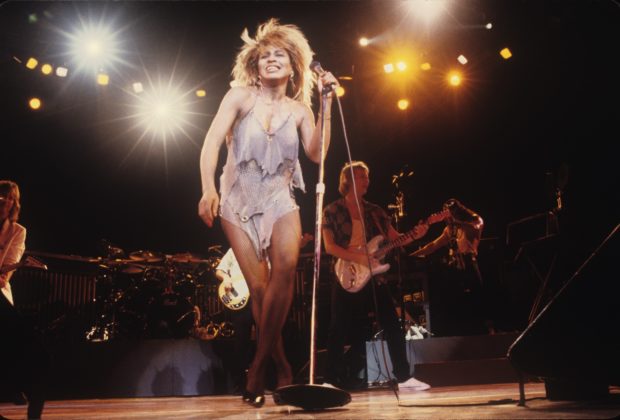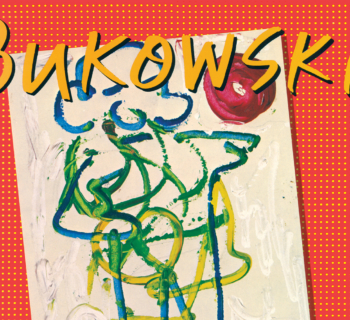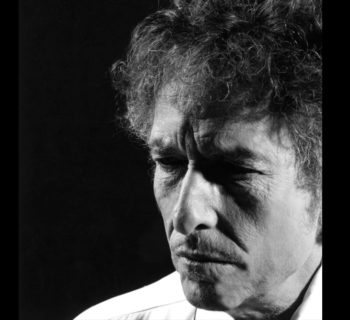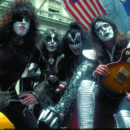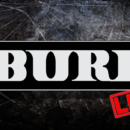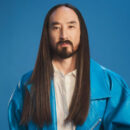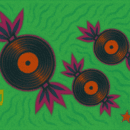Singer/performer and author Tina Turner will be the subject of a documentary from the filmmakers who were behind the acclaimed Searching For Sugar Man and Whitney.
It’s directed by TJ Martin and Dan Lindsay, and produced by Simon and Jonathan Chinn’s Lightbox. HBO Documentary Films in the U.S. and the Sky Channel in the U.K. will premiere the movie this year.
The HBO documentary examines Turner’s career, from her days with the Ike & Tina Turner Revue through her combative marriage to Ike, and her subsequent survivor story journey where she became one of the biggest-selling solo performers in the world selling over 200 million record sales. The movie incorporates interviews with Turner, her friends and key collaborators.
Tina- The Tina Turner Musical based on the life story of Tina Turner, which opened on London’s West end in April 2018, that starred Adrienne Warren, came to Broadway in November of 2019, just before her 80th birthday. Warren later reprised her role at the Lunt-Fontaine Theater in New York. The West End show was directed by Phyllida Lloyd (Mamma Mia!). Playwright Katori Hall (The Mountaintop) collaborated on the book with Frank Katelaar and Kees Prins.
On her official website, Turner displayed a statement about Tina.
“It’s really important to me to have the chance to share my full story. This musical is not about my stardom. It is about the journey I took to get there. Each night I want audiences to take away from the theatre that you can turn poison into medicine.”
Tina Turner was Ike Turner’s protégé long before establishing her own identity, following well-chronicled deadly domestic abuse from Ike Turner, who she divorced in 1978, to an inspirational comeback saga, further explored in her 1986 international best-seller autobiography, I. Tina: My Life Story, published by William Morrow & Company.
Ike and Tina Turner were inducted into the Rock and Roll Hall of Fame in 1991.
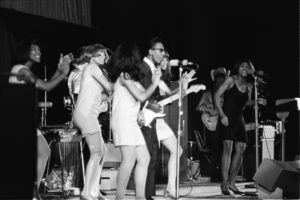
Photo by Henry Diltz
In 1993 the biopic What’s Love Got to Do with It, loosely based on Turner’s life became a film directed by Brian Gibson, which starred Angela Bassett as Tina. Ike Turner was portrayed by Laurence Fishburne.
On October 19, 2018, My Love Story, a second memoir from Turner was published by Atria, a division of Simon & Schuster. It revealed more confessions and explosive details about former husband Ike, Tina’s solo musical recordings, concert triumphs and romantic bliss over the last few decades.
In this autobiography Tina Turner reveals she was battling kidney disease in 2016 and underwent a kidney transplant in Switzerland during 2017 and the donor was her husband, Erwin Bach, a German record executive. They were married in 2013.
In 2018 Tina Turner was honored with the Grammy Lifetime Achievement Award.
During 2019, the Phil Spector-produced "River Deep, Mountain High" recording, initially sung by Tina Turner at an epic 1966 Gold Star recording studio session in Hollywood, was spotlighted in the acclaimed 33 1/3 - House of Dreams stage play at the San Diego Repertory Theatre Lyceum Stage Theatre which tells the story of the landmark Gold Star facility and its co-founder, engineer and hit maker Stan Ross through the history of rock ‘n’ roll.
It’s written by Jonathan Rosenberg and Brad Ross, with additional contributions by Steve Gunderson and Javier Velasco. Their play broke attendance records in the 44 year history of the Southern California facility. Janae Parson was terrific in her role as a shimmering Tina Turner. There are 2021 plans to bring 33 1/3-House of Dreams to New York.
In the late sixties and early seventies long before Tina was heralded for her Mark Knopfler-written and John Carter-produced “Private Dancer” comeback and the subsequent Capitol Records-birthed music videos on heavy rotation on MTV in the eighties, I witnessed dynamic performances by the Ike & Tina Turner Revue many times around Southern California.
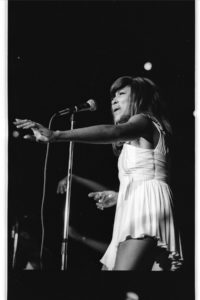
Photo by Kurt Ingham
The team opened for the Monkees at the Hollywood Bowl in 1967. I caught them in June 1969 as one of the support acts for the Jimi Hendrix Experience at the Newport ’69 pop festival in Northridge, California. In November 1969 I watched two sets one very long night on November 8th when the Rolling Stones’ ’69 US tour rolled into Inglewood at the Fabulous Forum.
During 1970 I was present at one of their Whisky A Go Go gigs, and on July 4, 1975 I saw Ike & Tina at the Concerts at The Grove nightclub on Wilshire Blvd., formerly The Coconut Grove room, at The Ambassador Hotel in Los Angeles.
I reviewed it for the July 26, 1975 issue of Melody Maker. I wrote, “Tina, clad in a revealing black dress, stomped and romped in front of Ike’s impressive funky rhythms on guitar. Tina is on the brink of well- deserved solo success, and her forthcoming solo LP, along with her Tommy performance, only makes her career with Ike even stronger.”
Ike Turner was born in Clarksdale, Mississippi. Turner and his band created “Rocket 88” for their singer Jackie Brenston and his Delta Cats considered by some as the first rock ‘n’ roll record in 1951.
Multi-instrumentalist Turner had been a deejay and a talent scout for Sam Phillips’ Sun Records, discovering B.B. King and Howlin’ Wolf. In the early 1950s, as an A&R man, Ike arranged recordings for the Sun, Modern and RPM record labels for Bobby “Blue” Bland, Little Milton, Elmore James, Roscoe Gordon and Howlin’ Wolf.
I always admired Ike as a bandleader, guitarist, record producer/arranger and founding father of the rock ‘n’ roll.
Brownsville, Tennessee, is the birthplace of Tina Turner who has come a long way since she started her career singing as Annie Mae Bullock in talent shows and the gospel choir in Knoxville.
In the mid-Fifties, Annie Mae moved to St. Louis with her sisters, and subsequently met Ike Turner. Tina soon joined Ike's group, the Kings of Rhythm.
In 1959, Ike wrote a number “A Fool in Love” for a singer named Art Lassiter who never showed up for the recording session. But Tina was familiar with it and stepped in, since studio facilities were paid for in advance. It became a hit on Juggy Murray’s Sue Records.
Ike then changed her name Anna Mae to Tina, because it rhymed with Sheena, homage to Turner’s favorite fictional American comic book jungle girl heroine, the character Sheena, Queen of the Jungle.
During the decade the Ike & Tina Turner Revue had a number of R&B and Pop chart records: “It’s Gonna Work Out Fine” and “I Idolize You.”
I was an avid collector of all their recordings on the record labels Sue, Modern, Kent, Tangerine, A&M, Loma/Warner Bros., Philles, Blue Thumb, Minit, Liberty, and United Artists.
In 2021 I now fondly remember with pleasure my 1975 interview with Tina Turner, following a delightful chili-driven dinner I had with her at Chasens restaurant in Beverly Hills.
Even Tina’s wig, always an essential part of her daily wardrobe, looked awesome.
At the table Tina had a confidence and calm that could probably be credited to her interest and spiritual practice of Nichiren Buddhism starting in 1973. She was raised a Baptist.
Our interview was first published in the October 11, 1975 issue of Melody Maker. The headline read Tina Turner: Acid Queen.
My conversation with Tina occurred before she fled from Ike, bolting to freedom, in the summer of 1976, after enduring years of terrifying emotional and physical mistreatment from him.
When the Ike & Tina Revue disbanded in 1976, they were married in 1962, and divorced in 1978, Tina was then guided and supported by Mike Stewart, President of the United Artists record label and Music Publishing companies for the United Artists Music Group. Turner was deep in debt from cancelled Ike & Tina obligations, but soon resumed touring as a cabaret artist with financial help provided by Stewart.
By 1979 Tina acquired Roger Davies as a manager. In 1981 after Rod Stewart attended her show at Jerry Brandt’s rock club The Ritz in New York City, he invited Turner to join him when he performed “Hot Legs” on Saturday Night Live. Tina did some support spots on the Rolling Stones’ 1981 US tour and waxed a cover of the Temptations’ “Ball of Confusion,” programmed on the fledgling music video cable channel MTV.
Tina’s recording career was truly rescued by a fan named David Bowie. He touted her commercial potential and potent live performances, along with Keith Richards, to Capitol/EMI record executives when she returned to Brandt’s venue The Ritz in 1983, who eventually signed Turner to the label.
A 1983 cover version of Al Green’s “Let’s Stay Together” yielded a Top Ten hit in the British sales chart and then the company demanded a full album, subsequently titled, Private Dancer. The following year Tina’s next single “What’s Love Got to Do With It” written by Terry Britten and Graham Lyle, went to number 1.
In our 1975 dialogue, Tina was impressed when I told her I first heard Ike & Tina Turner 45RPM’s in the very early sixties on the AM radio soul station KGFJ as a youth with my family in Culver City. We had lived in Crenshaw Village neighborhood nearby Ike’s Bolic Sound recording studio in Inglewood where she and Ike now worked.
Wearing a white jumpsuit, Tina was articulate and candid in our encounter.
"I've talked to a lot of reporters lately because of the Tommy movie and we decided to call the album, Acid Queen, to help capitalize on my role in the movie," suggested Tina Turner inside the Bolic Sound complex.
An earlier LP Come Together, which contained the hit Beatle tune and their cover of “Honky Tonk Woman,” climbed high on the national charts. Following successes have included the million-selling “Proud Mary” single, a gold album What You Hear Is What You Get (Live At Carnegie Hall), and the hit single and album, Nutbush City Limits.
"We toured for years with all the English groups and I always liked what they were singing about,” enthused Tina, who in 1966 at Colston Hall in Bristol, England in a hallway corridor taught Mick Jagger an interpretation of the sideways pony dance in front of Marianne Faithfull, Brian Jones, and Keith Richards.
"I've wanted to do an album like Acid Queen for some time," she explained. "There's a lot of Mick Jagger's songs that we haven't gotten around to doing. The concept of the album came from my producers, Denny Diante and Spencer Proffer. At first the album was going to be called, The British Album, with the whole album full of British songs.”
There are four other English numbers on the album: “Under My Thumb,” “Whole Lotta Love,” “'I Can See For Miles,” and “Let's Spend The Night Together,” which complete the first side. Side two features five original compositions, with “Rockin' And Rollin'' and “Baby – Get It On” the most striking.
"But Ike sent out word that he wanted the album out immediately,” said Tina, “so after I did a commercial for Dr. Pepper, earlier in the day, I did the vocals at nine o'clock in the evening and hardly got a chance to learn the songs.
"The album was a bit rushed, but I've done it this way before. We've done a lot of albums without spending that much time on them. All that was left was for me to cut the vocals 'cause Ike, Denny and Spencer got everything else together.
"We were in Seattle a few years ago in a record store and I heard this bass riff opening on ‘Come Together.’ I said ‘I had to do that song,’ the same with 'Proud Mary.’ I've been trying to get Ike for two years to record it. We've always done other people's songs successfully and it's not uncomfortable doing songs by the Who, Led Zeppelin and the Stones.
"Ike and I haven't got the time to develop as songwriters 'cause we spend so much time in the studio and on the road. And there's a lot of good music to be covered."
She's very much a singular force these days, and for the first time there are press kits with pictures of Tina sans Ike.
"It's still the Ike and Tina show," she reinforced. "Ike and I are singing a bit more together on stage, and maybe all the Tommy promotion has put a bit more of the focus on myself,” explained Tina.
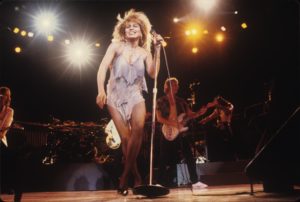
Photo by Henry Diltz
"We've been trying all these years to get to the point where the whole show is sharp. When we went into Las Vegas we changed the show around and the Ikettes added six songs to the repertoire. They're much better now. All these years we've wanted the whole package to be good. Ike selects the songs and there's a tremendous amount of preparation for our tours."
Tina’s billing in the Who’s rock opera Tommy generated praise from reviewers. Ike & Tina's exciting performances in The Big TNT Show, Gimme Shelter, and Soul To Soul, just captured them in a live setting.
"Tommy was a whole new trip for me, getting into a room and turning into a mad woman. At first I didn't want to play the part of a prostitute. But it was a challenge and it called for drama. That's what acting is all about.
"Travelling across the country now people are beginning to know me as the 'Acid Queen.’ The audience is screaming for the song when we perform live."
Sexuality has become a trademark of the Ike & Tina spectacle. Her use of bold expression, techniques often goes beyond the platform tease category. Some reports suggest their stage act exploits sex.
The show is toned down for the supper club circuit; a slight degree of hesitation, but there's always a huge amount of titillation.
But, she sternly says: "I never felt we've used sex as a gimmick in our program. It's important today because, people who pay to see a show want a little of everything.
"The sexual portion of our show isn't planned; it just happens. It works out well visually and it always seems to get the most audience response. Everybody needs an image. There's a million groups out today; flipping, smoke bombs, dancing – fortunately, everybody can't be sexy. We've discussed it a thousand times, the mini skirt and see-through dresses.
“People's minds do wander… We may do a song like 'I've Been Loving You Too Long,’ and work with it. Every time we do it, the song changes. Sometimes I really have a lot of fun with that song because people expect something to happen.
"For years we've gotten reviews that seem to dwell on the sexual aspect of the show. I've never felt people gaining sexuality after seeing our show. But I like them to remember what they have just seen. I've never really thought of our show as being aggressive. Even as wild as I am I know that I maintain my femininity. People have always told me that.”
In 1975, Tommy brought a rash of talk show interviews for Tina, and media coverage bloomed. The press in general, however, has chronicled the Turners, while turning up nasty rumors and juicy gossip.
"I'm not a worrier. I've read a few things over the years that I laugh about. 'She must be over 50' or, 'Ike messes around with the Ikettes.' It goes in one ear and out the other. We laugh about it. If it’s really shocking you can't let it bother you."
Then she grins. "Some of it is true. There are a few incidents that I can't live down, like the time in Las Vegas when I was running around the stage in my heels and I slipped because we were using the bubble machine. Wham! I fell, spread out across the floor, with my crotch to the audience. Luckily I wasn't hurt."
Throughout 1965 the Ike & Tina Turner Revue were seen nationally on Los Angeles-based rock ‘n’ roll television programs including Shindig! and Hollywood A Go-Go. The husband and wife duo earlier appeared on Dick Clark’s American Bandstand in 1960.
However, it was a tragic period where black people were still victims of overt discrimination even on the road. Tina cited some miserable scenes where there weren’t places to sleep, the tour bus never got a chance to stop and band members were subjected to numerous racial insults and incidents.
“When they came west, the Ike & Tina Turner Revue not only toured relentlessly, the played worked everywhere they could in SoCal,” emphasized music journalist Kirk Silsbee in a 2021 email.
“They played the California Club and the 5-4 Ballroom to black audiences, they played teen clubs like the three Cinnamon Cinders--Studio City, Long Beach and Alhambra—they even played bowling alleys. They were a presence in SoCal. By 1965, they cracked the Sunset Strip, playing the Red Velvet Club—not coincidentally where the Shindig! wrap parties were held. When Ike & Tina made it onto Shindig!, they were clearly in ascendance. That’s why Phil Spector put them in The Big T.N.T. Show and cut Tina for ‘River Deep, Mountain High.’
“I think Ike is a very underrated guitarist. He was inventive, with rhythm and the actual sounds that he got from the instrument. If you listen to instrumentals like ‘The New Breed’—you’ll hear Ike stretching boundaries. And Jimi Hendrix certainly listened to Ike when he gigged with Ike & Tina.
“Ike was a real bandleader, and you didn’t always get real bandleaders in R&B. You may have had artists who cut with good studio outfits, but if they were lucky enough to get hit records, they were thrown out on the road at the mercy of hastily assembled traveling bands, or house bands that might not know their material. That wasn’t the way Ike operated. He kept a highly-disciplined, cutting-edge playing and recording unit that could go on the road--and play the shit out of the music--or take it into the recording studio at a moment’s notice.
“Ike continually generated his own material,” added Kirk. “He could produce it. He molded a great singer in Tina, and he provided her with a very good backup unit—the Ikettes. So, in a way, Ike Turner was like Phil Spector if Phil had been performing.”
"The biggest change started happening when we were working around LA in 1966 and ran into Phil Spector,” underscored Tina. “He wanted to record me and when we cut 'River Deep, Mountain High' Mick Jagger, who was visiting Phil at the time, was in the studio.”
Ike and Tina Turner were now being ushered into the big leagues.
In a 1988 interview with keyboardist/arranger/songwriter Jack Nitzsche, he discussed “River Deep, Mountain High” and the epic recording session at Gold Star studio.
Brian Wilson, Dennis Hopper, Mick Jagger and Rodney Bingenheimer were in attendance. The song written by Jeff Barry, Ellie Greenwich and Spector, was released in the U.S. on Spector’s Philles Records.
“Phil was the co-writer on the song. Phil embellished the song and was the producer. I’ve talked to Gerry Goffin about that a lot; Phil co-writing songs that he would produce. Phil would always have the writers come over and write in the room with him, and I knew he directed it. They all say the same thing; that without Phil Spector in the room that song wouldn’t have been that way. He helped. He knew what he wanted it to be.
“I know Phil Spector helped write ‘River Deep, Mountain High.’ Phil said, 'I've got a song for Tina.' I went over to Phil's house and went over the arrangement note by note. When Phil played me ‘River Deep, Mountain High’ on the piano I knew it was a great song.
“We did the rhythm track in two different three-hour sessions. Even during the cutting of the track, when she was putting on a scratch vocal, Tina was singing along as we cut it. Oh, man, she was great, doing a rough, scratch vocal as the musicians really kicked the rhythm section in the ass.
“Tina was the vocalist. Background groups doubling and tripling so it would sound like two or three dozen voices. Phil would spend a lot of time with the singers. I would split and he’d still be working on lines with the singers. The rhythm section and the horns were done together. Vocals and string parts were overdubbed later,” detailed Jack.
“Once in a while a vocalist would run through a song, but this time Tina made everybody play better. When I first heard the intro I didn't like it very much, but once it was being recorded it all made sense. It was real good.”
“I like to have all the musicians there at once,” Spector stressed to me in a 1977 interview conducted with him inside his Beverly Hills mansion for the new defunct Melody Maker.
“I put everything on 24 tracks just to see if it’s plugged in. The finished track never ends up on more than one track. I record basic tracks and then put it all onto one track or maybe two. The musicians I have never outdo me. I’m not in competition with them. I’m in complete accord with them. Then I condense. I put my voices on. Singers are instruments. They are tools to be worked with.
“You tell me how many names you immediately remember in the cast. One? Two? It's the same with Fellini, and that's what I wanted to do when I directed a recording.
“My graduating theme [from Fairfax High School] was ‘Daring To Be Different,” Phil announced. “The moment I dared to, they called me different. I always thought I knew what the kids wanted to hear. They were frustrated, uptight. I would day no different from me when I was in school. I had a rebellious attitude. I was for the underdog. I was concerned that they were as misunderstood as I was.”
“I respect Phil. He could do it all,” enthused Jerry Wexler, the Atlantic Records executive and record producer in 2006.
“The song and the recording existed in his brain. Phil’s records were made in his head before he even entered the recording studio.
“When Phil went into the studio, it came out of him, like Minerva coming out of Jupiter’s head. Every instrument had its role to play, and it was all prefigured. The singer was just one tile in this intaglio.
“How could I later argue with the results and success when Phil really became a record producer with his wall of sound and his studio mesh of instruments? Although I like records with more definition,” admitted Wexler.
“Our echo chamber gave it the wall of sound feel,” Gold Star co-owner Stan Ross reinforced in a 2002 interview now incorporated in my 2020 book, Docs That Rock, Music That Matters.
“Dave (Gold) built the equipment and echo chamber and personally handcrafted the acoustical wall coating. We had so much fun with that echo chamber; it never sounded the same way twice. We kept tubes on longer than anyone else. Because we understood that when a kick drum kicks into a tube microphone it’s not gonna distort.”
“I used to have a theory,” Gold Star staff engineer Larry Levine mentioned to me in a 2002 interview, “that in recording songs Phil needed to tire out the musicians, or they got to the point where they were tired enough so they weren’t playing as individuals. But they would meld into the sound more that Phil had in his head.
“As far as the room sound and the drum sound went, because the rooms were small, with low ceilings, the drum sound, unlike other studios with isolation, your drums sounded the way you wanted them to sound. They would change accordingly to whatever leakage was involved.
“Phil once said to me the bane of his recording existence was the drum sound. A lot of people attribute to echo what Phil was doing. The echo enhanced the melding of the wall of sound, but it didn’t create it. Within the room itself, all of this was happening and the echo was glue that kept it together.”
Rodney Bingenheimer, before he held a weekly Sunday deejay spot on SiriusXM satellite radio this decade, as a teenager went to the recording session of "River Deep, Mountain High."
"I saw Ike & Tina Turner at The Big T.N.T. Show filming on November 29, 1965 in Hollywood at the Moulin Rouge club on Sunset Blvd. that Phil Spector produced and was the music coordinator,” Rodney proudly declared.
“Ike & Tina were great! They did ‘I Think It’s Going to Work Out Fine’ and ‘A Fool in Love.’ Donovan, Joan Baez, the Byrds, Ray Charles, the Lovin’ Spoonful, Roger Miller, the Ronettes, Petula Clark, Bo Diddley and MFQ were also taped.
“I spent some time with the host, the actor David McCallum. We talked about music. His father was a classical musician in England. The Ronettes were amazing. The whole taping was an incredible cosmic event.
“A year afterward PF Sloan and I saw Ike & Tina at a club on Sunset Strip called The Galaxy. Tina did a stage trick pulling her dress above her knees as the band played. Now that was rock ‘n’ roll!
“A little later in March of ’66, I was in Hollywood and went to the Wallichs Music City record store on the corner of Sunset and Vine. I was listening to records in one of their booths and ran into Brian Wilson, who was also in the store. I told Brian that Phil was doing a session at Gold Star down the street. He said, 'Let's go!' So we walked down the block from Sunset to Santa Monica Blvd. where Gold Star was located.

Courtesy of Universal Music Enterprises
“The first person I saw was Mick Jagger. He was wearing a mink fur-coat. And he sat behind the console next to Phil. Mick kept leaving the booth to use the telephone where he called a girl. I took pictures with my Brownie Instamatic camera. Mick told me I should save film and take a photo of the girl!
“Brian and I sat by the window in front of the booth in the studio during the recording of 'River Deep.' You don't leave when you're at something like this. We were transfixed. Brian didn't say a word. He soaked it in and sat there stunned. The engineers were Larry Levine and Stan Ross. Phil was in control!
“Jack Nitzsche and Phil were very tight. They were like co-pilots on the Concorde from a flight from France.
“Phil was screaming like a madman during the sessions. Tina was loud and sexy. She was wearing a wig and Go-Go boots, very sixties. Tina's vocals kept on soaring. Dennis Hopper showed up. He later took photos and did artwork for the River Deep, Mountain High album that came out much later. He was very quiet.
“Some of the musicians wore Alpaca sweaters. Phil and Jack dressed like kids. They wore clothes from DeVoss and Beau Gentry, where the Beach Boys, the Beatles and the Rolling Stones shopped. And everyone wore Caesar cologne. Even the diamond-shaped bottle looked great. They wore dark glasses and puffy-sleeve shirts and boots. They didn't look like record company people. They were listening to the song as it was played over and over. It was really in the pocket.
“The single of ‘River Deep, Mountain High’ didn’t get much radio airplay on the Los Angeles stations,” lamented Rodney in January 2021.
“In late 1966 I bought the River Deep- Mountain High LP on London Records as an English import on Hollywood Blvd. at Lewin Record Paradise. Tony Hall of Decca Records did the liner notes.”
“I did four or six tracks on that Ike and Tina Turner [River Deep, Mountain High] album, including ‘A Love Like Yours (Don’t Come Knocking Everyday),’” volunteered legendary engineer and record producer Bones Howe to me in a 2014 interview.
“I didn’t get to know Phillip [Spector] in the late fifties and early sixties ‘cause he was working at Gold Star and I was at Radio Recorders and then I went to United.
“I knew who he was. I met him a couple of times. And then in 1966 he called me up and was doing a Tina Turner album and wanted to do the whole orchestra live and Larry Levine at Gold Star couldn’t do it. So Larry called me and asked ‘Do we think we can do this at Studio A at United?’ ‘Absolutely.’
“And I had worked with Ike and Tina at Studio B at Radio Recorders and Ike used to pay in cash. Ike had the girls and he paraded the girls. I liked Ike. He was a good guy and I had a good time working for him,” remembered Bones.
“Larry came over and clued me in on how to set up the wall of sound tape reverb echo and all that stuff. I had some idea what Stan Ross and Larry Levine had to go through at Gold Star to make Phil’s records. It was tape reverb and the chamber. I knew what it was. But doing it and finding a way to make it work on a record is a different thing. I knew what it was technically.
“For one thing, Phil had this vision of what the sound should be like. And it was his sound. And you’d hear a baritone saxophone suddenly that would pop out. It just had all of these wonderful things happening in his tracks that worked with his recordings and his artists. And Phil knew the song meant something. People were buying songs not sound.”
“River Deep, Mountain High” only reached number 88 in the US Billboard singles chart, but a number 3 position in the UK market.
John Lennon called “River Deep, Mountain High” a “masterpiece.” George Harrison provided a front jacket blurb on the Spector produced Ike & Tina Turner River Deep, Mountain High album: "It is a perfect record from start to finish. You couldn't improve on it."
“River Deep, Mountain High” also impressed Mick Jagger.
In our interview, Tina reminisced, “After hearing the song he wanted us to tour England in 1966 with the Rolling Stones. The English weren't used to seeing girls with high-heeled shoes and I think they were shocked a bit.”
In 2007 I asked Andrew Loog Oldham, who managed the Rolling Stones and produced their 1963-1967 recordings, about that fabled ‘66 12-date tour which started on September 23, 1966 at the Royal Albert Hall. Oldham hailed “River Deep, Mountain High” in his own paid-for advertisement in the weekly Disc and Music Echo periodicals.
“The '66 tour with Ike & Tina Turner and the Yardbirds was a give something-back-to-the- fans-type of thing. Ike & Tina were a 17-piece review; you were not making money putting them on the bill.
“On top of that, Tina had had the Phil Spector record in July, ‘River Deep, Mountain High,’ that we had championed and if we, the Stones and I, were not going to bring them over-- nobody else was. And the UK deserved to see what we had been fortunate enough to witness in the US.
“Long John Baldry was the host of that tour. We had so much music on the bill we could only offer him the compere spot. John was the beginning for so many- the hope. We wanted to honor that by having him on the tour,” underlined the Rock and Roll Hall of Fame member.
"Every night on our tour in Southern France we got three, four and five encores,” confirmed Tina. “We're much bigger in Europe than here in America. We'd need a lot of hits to be as big here. I feel we're totally accepted in Europe. I'll always remember Europe and England for making 'River Deep, Mountain High' a hit.
“Mick then came to the States in 1969 and asked us to tour America with him later in the year. That's when it happened.
"We played the Forum, Madison Square Garden, and all the big arenas. Like Vogue said it best: ‘They came to see Mick Jagger but they saw Ike and Tina and they've been comin' ever since.’
“From there on we crossed over to the pop market and it's been that way ever since.”
During 1969 I attended West Los Angeles College with Tony Funches, who in late 1969 served as Mick Jagger’s lone bodyguard and headed security for the Rolling Stones’ ’69 US tour.
Tony is seen in the documentary Gimme Shelter at the ill-fated Altamont concert and inside recording sessions at Muscle Shoals watching the band cut “Wild Horses” “Brown Sugar” and “You Got to Move.” From 1970-71, Funches was hired to “protect” Jim Morrison of the Doors.
In 2016 Tony spoke to me about Ike & Tina Turner and the Stones on their US ’69 trek.
“The Stones always supported black talent. I’ll give Keith and Mick props on this. Along with Charlie Watts and Mick Taylor, Ian Stewart, all of the Stones very early on, when I became associated with them, had no problem standing on their hind legs in front of me and extolling the virtues of all these artists that they had idolized as kids. And that impressed me quite a bit to hear that coming from them.
“Remember, at the time, as kids, England was listening to this stuff and England was still a bombed out war zone from World War 2. Rationing was still on. Everybody was dirt poor. Here are these kids in a bombed out nation that had no intra structure left and still on rationing were listening to old rhythm and blues and old acts. And when they find success they feature the original guys to do stuff?
“Ike Turner led that band every night. Absolutely. He picked the studio and stage repertoire. A consummate professional, Ike had his initial success as an arranger. He had been in the business before I was born. He was part of the St. Louis and Chuck Berry rhythm and blues community, as opposed to Chicago and Los Angeles. He wound up in LA in the early sixties.
“Anna Mae Bullock, who became Tina Turner, her hometown was Nut Bush, Tennessee. And here they are, in View Park, the Baldwin Hills area, on the whole tour.
“The Rolling Stones are tied to the musical legacy of Los Angeles Modern and Kent Records. Ike and Tina along with B.B. King had been on both of those record labels.
“They are a product of Los Angeles. Look at the album credits in the sixties and early seventies.
“When the Stones were in Hollywood we saw Little Richard when he played the Whisky a Go Go. Mick and Keith jammed at Thee Experience with Bob Diddley. Mick saw Chuck Berry at the Whisky. I remember The Ed Sullivan Show taping at Television City in Hollywood. We also went to the Whisky to see Hugh Masekela and the Chicago Transit Authority. I was with Mick and Keith when all the overdubbing and mixing were going down on the track “Gimme Shelter” at Elektra Studios on La Cienega and Sunset Sound.
“I talked to the band about the 5-4 Ballroom in downtown LA where Dinah Washington, Sam Cooke, Muddy Waters and James Brown had played. They knew about the 5-4. And in fact, I told them, ‘You are not going in there. It’s upstairs, there is one door in and one stairway up and one stairway down. Once you are inside if the bullets start flying you got nowhere to go except fall over the balcony or get trampled by everybody tryin’ to run down the stairs. So forget about the 5-4. Do you understand me?’
“It was 54th and Slauson. It is a junior morgue. And anybody can get dead there in a blink of an eye. Etta James used to play the 5-4. Jumped off the bandstand, in fact, broke her wrist on one of the women in the audience, wrapped her hand up, climbed back up on the stage and finished her set. ‘Do you understand what I’m saying? Keith? You aren’t going to the 5-4 Ballroom. Period.’
“On the ’69 tour Tina was busy backstage. Don’t mess with that woman. Leave her alone and stay out of her way. Yes she was gorgeous, but any woman who has that much energy and commands a room the way she can, give her space and peace. Stay out of her way. ‘Yes ma’am.’
“Besides, Ike had a straight razor and a derringer on him at all times. (laughs). I ain’t ready to die over this.
“B.B. King was a gentleman, wonderful cat. I was aware of his manners, his professionalism, how kind he was to everybody. Not arrogant or rude. Gracious, polite, well spoken.”
The Rolling Stones, Ike & Tina Turner, B.B. King November 8, 1969 two shows at the Fabulous Forum venue in Inglewood were monumental moments in the musical history of Southern California. Terry Reid was also on the 1969 jaunt and did a short set on the first show that memorable evening.
The first concert started on November 8th at 11:45 pm and the second one spilled into November 9th ending at 5:15 am.
B.B. King’s “Paying the Cost to Be the Boss,” on the Bluesway/ABC record label, was a Top 10 R&B hit in 1968, and popular on the KGFJ-AM radio station. King’s opening slot on the Rolling Stones’ ’69 tour and especially his November 8th shows at the Forum was a career-changing opportunity.
B.B. wailed in front of music reviewers, rack jobbers, AM and FM deejays, booking agents, managers and paying folks who had never heard, let alone seen, him in action. The enthusiastic crowd worshiped King on his hometown stage. It was a moment in which he knew, that by the following Christmas, his next forty five years of studio dates and jobs were going to be well taken care of.
Looking back now after a half century at this collective life-altering experience, I think Tina Turner also realized her name and likeness would be on a marquee or a television screen in 2020.
My fellow Forum concert attendee Paul Body is a drummer, writer and poet. We were both in that huge room alone, but together.
Paul emailed me earlier this century.
“It was a cold November night in 1969. It was way past 12 in the morning and the first show was still going on. Man, the Stones made you wait. It was their first tour and they were way past the British Invasion, they were way past that whole English mop top thing. This was 1969, and they were the STONES. They were the World’s Greatest Rock and Roll Band. We had to wait until 2 in the morning to see if they lived up to that moniker.
“First things first, missed the opener Terry Reid, I can’t remember why. Maybe we were eating at the House of Pancakes across from the Forum. Anyway, we did get to see B. B. King do his thing. It was a slick chitlin’ circuit set. Remember this was just before ‘The Thrill Is Gone.’
“I remember that his band, Sonny and the Unusuals, had these shiny jackets on, and they were swaying to the grooves. They were super pros, and they made us forget the hours that we had spent waiting. We went to the school of blues that early morning at the Forum. Of course, he did ‘Sweet 16’ and he made ‘Lucille’ sting and bite.
“It was even later by the time the Ike & Tina Turner Revue came on complete with funky dancing Ikettes and super sexy Tina. She wasn’t a lady from the canyon or anything like that. She was the sexiest thing on Prairie Avenue. This wasn’t bobby soxer or going to prom music. This was music for and about the midnight handicap. I couldn’t keep my eyes off the stage. I had seen them a few months earlier at the Rose Palace in Pasadena but they were a lot more sweaty opening for the Stones.
“By the time the Stones came on, it was real late. This was their second show of the night and from the opening riff of ‘Jumpin’ Jack Flash’ they were cooking the gator, they were lean, clean, and oh so bluesy.
“You have to remember this must have been about four in morning. When they did ‘Carol,’ I thought the Forum was going to lift off. They sounded like a locomotive pulling into Barstow. They weren’t jiving.”
“As for Ike & Tina Turner,” proclaimed record producer and songwriter Kim Fowley in a 2008 interview I had with him, “after touring with the Stones in 1969, the drawing power of both acts went up. It was good they were on the ’69 Stones’ package. New people got to see them nightly in big joints. Both B.B. and Ike & Tina went to Las Vegas. Someone is getting paid.
“I will say this: Ike Turner was the real Sam Phillips. And Ike Turner produced ‘Rocket 88.’ He was the leader of the band and he produced the record. And that was the first rock ‘n’ roll record ever and never got the credit for it. Ike Turner was the father of rock ‘n’ roll the recording studio version and he is also the father of rock ‘n’ roll guitar. Before Chuck Berry showed even showed up in a studio Ike Turner was cutting hits.”
March 2019 also marked the 50th anniversary of Ike & Tina Turner’s Outta Season album released on Blue Thumb Records in 1969, a collection of new studio work and available singles. Tina and Bob Krasnow were the producers of the LP that spawned a cover of the Jerry Butler/Otis Redding tune, “I’ve Been Loving You Too Long,” that scored in the Billboard Hot 100 chart.

Courtesy of Universal Music Enterprises
The track was on FM radio rotation in the Los Angeles region on KMET-FM. I suggest viewing Tina’s “live performance art” rendition of the song and her intimate relationship to the language of the lens in the Albert Maysles, David Maysles and Charlotte Zwerin-directed 1970 Gimme Shelter documentary.
“I first met Bob Krasnow when he worked at Buddah Records,” recollected artist manager and record producer, Denny Bruce in a 2021 interview.
“He had started in 1968 a new record label, Blue Thumb, and he gave me a call. ‘I understand you manage Magic Sam and I want to sign him.’
“I agreed to a meeting with him in his new Beverly Hills office, on Canon Drive. He was financed by GRT Tapes and had big plans for signing big acts. But he really wanted to start out with good blues acts, to keep the ‘blue’ in Blue Thumb. I told him Magic Sam was not ready, due to previous deals, for ‘awhile.’ But Mike Bloomfield and Nick Gravinites are going to produce his album, and they have good acts now looking for deals.
“I also managed Albert Collins and was able to lease his best album to Blue Thumb, Truckin’ With Albert Collins. Magic Sam and Charley Musselwhite were touring together, and I made a deal for The Chicago Blues All-Stars which was Charley and well known bluesmen in his band. Mike and Nick produced Sam Lay (original drummer of the Paul Butterfield Blues Band). I leased A Best of Clifton Chenier album, and another client of mine, Earl Hooker, came on board.
"I met Dan Bourgoise who managed Del Shannon in the Blue Thumb office when he also repped Southwind.
“Krasnow had been in talks with Ike Turner about a deal for Ike & Tina. Bob called me and said he needed my help in explaining to Ike how a good, raw, bluesy album is not going to make his fans turn on him. He was blunt in saying black people don’t want to hear the blues anymore.
“I met with them on Canon Drive and told Ike the first concert I saw when I moved to LA in 1963 was at Los Angeles Valley College in the girls’ gymnasium at 11:00 am.
“Their white bus was parked at the rear entrance. It was a yellow school bus, but now was white, with ‘The Ike & Tina Turner Revue’ painted in red on both sides. The show began with a comedian. Then a singer came out and did ‘Stand By Me.’ The Ikettes did two songs. Then the band plays an instrumental and Ike joined in and did some nice guitar work before saying ‘It’s star time, ladies and gentlemen.’ Tina maybe got to do three songs before the school shut them down. It was time for the next class.
“I had a nice talk with Ike about his role in blues history, and how he keeps his music and show current.
“I explained the concept of the album would be in picking good songs, showcasing how good Tina sings them. I told him all of my friends love them, and want to see Ike & Tina playing places like the Fillmore in San Francisco, promoted by Bill Graham. The record will be promoted to FM radio and if it goes the way it should they will share large concert stages all over the world. Groups like the Stones want them.”
“Ike asked me ‘why am I so sure they are ready to play concerts?’ I said ‘You have Tina and the girls out front and you lead a kick-ass band.’
“Bob is telling him ‘I’m right.’ Ike said, ‘OK. Let’s talk about money. I have another label that wants me, and has given me a good offer. I will show it to you. I want you to match it, and then kick in 5 k more than them, and pay me in cash by this Friday night!’
Bob says ‘Ike, they have made you a damn good offer. I’m willing to have cash for you this Friday.’ Ike says ‘I want the 5 grand, or no deal.’ Ike says “Take it or leave it.’ Bob laughs and replies, ‘Ike, 5 grand is a good night’s show in your pocket.’
“Now Ike gets mad. ‘Maybe you haven’t noticed but I work six nights a week, with this band, playing one-niters all over SoCal, so we go home and sleep in our own beds. I have 7 or 8 people on stage that must be paid. One cat leaves because he can make more money for less work, I’m screwed. Now, I have a new musician, or female singers, and make the band rehearse so new cats know the show. And we ain’t getting 5 grand playing Pancho’s in Manhattan Beach!’
“It was a club in the South Bay area. Ike told me he liked playing there. He and Tina would still be at home when the band started playing. I think he said it took about 30-45 minutes to get there and the house was always packed!
“I said to Bob, “Ike ain’t bull shittin’. This is business.’
“Bob and Ike walked across the street to the bank, on Friday, ten minutes before they closed.”
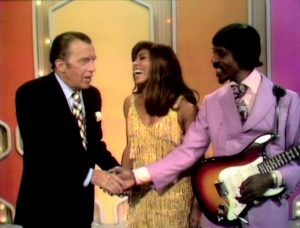
Ed Sullivan Show Courtesy of SOFA Entertainment
In 1970 Ike and Tina Turner earned a Top 40 hit with their cover of Sly & the Family Stone’s “I Want To Take You Higher” and appeared on influential The Ed Sullivan Show. Tina strutted out in a short, gold fringed dress, while the three Ikettes were in matching pink dresses and danced behind her. Bandleader Ike, in a lavender suit, stood tall, guitar in hand, while the group did his number “Bold Soul Sister” and Creedence Clearwater Revival’s “Proud Mary,” which became their biggest success, reaching #4 in the charts.
Host Sullivan then bid them farewell and told his TV audience he’d see the couple’s opening night in 1970 at the Las Vegas International Hotel.
Elvis Presley came by one show when he was headlining at the venue. Elvis told Ike he used to watch him play in the black clubs of Memphis around 1953, and ’54, just after he graduated high school when he was driving a truck for Crown Electric before he walked into his future home inside Sun Studios in the summer of 1953.
Harvey Kubernik is the author of 19 books, including Canyon Of Dreams: The Magic And The Music Of Laurel Canyon and Turn Up The Radio! Rock, Pop and Roll In Los Angeles 1956-1972.
Sterling/Barnes and Noble in 2018 published Harvey and Kenneth Kubernik’s The Story Of The Band: From Big Pink To The Last Waltz. For summer 2021 the duo has written a book on Jimi Hendrix for the publisher.
Otherworld Cottage Industries in 2020 published Harvey’s book, Docs That Rock, Music That Matters, featuring interviews with D.A. Pennebaker, Chris Hegedus, Albert Maysles, Murray Lerner, Morgan Neville, Curtis Hanson, Michael Lindsay-Hogg, Andrew Loog Oldham, Dick Clark, Ray Manzarek, John Densmore, Robby Krieger, Travis Pike, Allan Arkush, and David Leaf, among others.
Kubernik’s writings are in several book anthologies, most notably The Rolling Stone Book Of The Beats and Drinking With Bukowski. Harvey penned an endorsement for author Michael Posner’s book on Leonard Cohen that Simon & Schuster published in October 2020, Leonard Cohen, Untold Stories: The Early Years)
This century Harvey wrote the liner note booklets to the CD re-releases of Carole King’s Tapestry, Allen Ginsberg’s Kaddish, Elvis Presley The ’68 Comeback Special and The Ramones’ End of the Century.
In November 2006, Harvey Kubernik was a speaker discussing audiotape preservation and archiving at special hearings called by The Library of Congress.
Kubernik’s 1995 interview, Berry Gordy: A Conversation With Mr. Motown appears in The Pop, Rock & Soul Reader edited by David Brackett published in 2019 by Oxford University Press. Brackett is a Professor of Musicology in the Schulich School of Music at McGill University. Harvey joined a lineup which included LeRoi Jones, Johnny Otis, Ellen Willis, Nat Hentoff, Jerry Wexler, Jim Delehant, Ralph J. Gleason, Greil Marcus, and Cameron Crowe.
Harvey was seen in the 2013 BBC-TV documentary Bobby Womack Across 110th Street, directed by James Meycock. Bobby Womack, Ronnie Wood of the Rolling Stones, Regina Womack, actor Antonio Vargas, Chuck D of Public Enemy, Damon Albarn of Blur and the Gorillaz, and Bill Withers are featured.
Kubernik was also interviewed in director Matthew O’Casey’s 2012 Queen at 40 documentary broadcast on BBC Television and released as a DVD Queen: Days Of Our Lives in 2014 via Eagle Rock Entertainment.
In 2019, Harvey was interviewed for director O’Casey again on his BBC4-TV digital arts channel Christine McVie, Fleetwood Mac’s Songbird. The cast includes Christine McVie, Stan Webb of Chicken Shack, Mick Fleetwood, Stevie Nicks, John McVie, Heart’s Nancy Wilson, Mike Campbell, Neil Finn, and producer Richard Dashut. Premiere broadcast was September 2020.
Harvey Kubernik in 2018 was interviewed in the Chris Sibley & David Tourje-directed short documentary entitled John Van Hamersveld: Crazy World Ain’t It. Van Hamersveld designed the iconic Endless Summer visual image and album covers for the Beatles, the Rolling Stones, Jefferson Airplane, Grateful Dead, Bob Dylan, The West Coast Pop Art Experimental Band, the Beach Boys, Blondie, and the Kaleidoscope.
During 2020 Harvey Kubernik served as a Consultant on the 2-part documentary Laurel Canyon: A Place in Time directed by Alison Ellwood. Kubernik is currently working on a documentary about Rock and Roll Hall of Fame member singer/songwriter Del Shannon.
Kubernik appears on screen in director/producer Neil Norman’s GNP Crescendo documentary, The Seeds: Pushin’ Too Hard. Jan Savage and Daryl Hooper original members of the Seeds participated along with Bruce Johnston of the Beach Boys, Iggy Pop, Kim Fowley, Jim Salzer, the Bangles, photographer Ed Caraeff, Mark Weitz of the Strawberry Alarm Clock and Love’s Johnny Echols. Miss Pamela Des Barres supplied the narration. Debut broadcast on television in 2021.
This decade Harvey was filmed for the in-production documentary about former Hollywood landmark Gold Star Recording Studio and co-owner/engineer Stan Ross produced and directed by Brad Ross and Jonathan Rosenberg. Brian Wilson, Herb Alpert, Richie Furay, Darlene Love, Mike Curb, Chris Montez, Bill Medley, Don Randi, Hal Blaine, Shel Talmy, Don Peake, Kim Fowley, Johnny Echols, Gloria Jones, Carol Kaye, Marky Ramone, David Kessel and Steven Van Zandt have been lensed.

